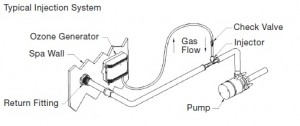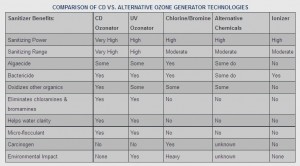Hi Pros,
I have been considering adding an ozonator to my spa for a while. What are the affects of an ozonator on hot tub covers?
Looking forward to your input.
Debbie from Columbus, Ohio
Ozonators are a controversial topic whenever they are mentioned. Lets share some of the devil in the details so you have a great base understanding.
Ozonators were all originally UV based, using a UV lamp to create ozone. Air is passed over the ultraviolet lamp. This separates the oxygen or O2 molecules into two O molecules. These quickly attach to other O2 molecules, combining to form O3 which is ozone. The ozone is then injected into the water as it cycles through the hot tub. It neutralizes contaminants by literally bursting the cell wall of the organism.
There are disadvantages of UV ozonators:
- Considerable more electrical energy is required to produce a given quantity of ozone by UV radiation than by corona discharge (discussed below)
- UV lamps solarize over time, requiring periodic replacement
- Highest concentration of ozone that can be produced by 185-nm UV lamp is 0.2 percent by weight, approximately 10% of the average concentration available by corona discharge
- Maximum ozone production rate is two grams/hr per UV bulb – depending on size
The Corona Discharge (CD) spa ozonator, first available around 1995, was a breakthrough technology in spa sanitizers. Finally, hot tub sanitation could be nearly automatic. Spa chemicals and their alternatives could not be removed from the top of the list of hot tub sanitizers. The CD ozonator is tremendously effective in a spa environment. It handles the gambit of contaminates and aids in water freshness and clarity.
The process of Corona Discharge ozone generation are varied, but work basically by passing air through an electrical field. The electrical current causes the “split” in the oxygen molecules as described in the section above.
There are advantages to a CD ozonator:
- Can create a more pure form of ozone without creating other harmful or irritating gases if using dry air or oxygen as a feed gas
- Can create high quantities of ozone (up to 100-lbs/day)
- Corona discharge ozone generators can use oxygen preparation thereby doubling the ozone output per given volume vs. dry air
- Corona cell life can exceed ten years
- Small construction allowing generator to be installed in virtually any area
The air going into the generator must be very dry. Moisture affects ozone production and causes nitric acid to form. Nitric acid is quite corrosive and can cause premature failure of the ozonator. It will increase the frequency of maintenance as well. Consider this if you live in an environment that is humid.
With that background in place, we must compare the effect of an ozonator vs. sanitizing alternatives. The chart at the left will help to explain the trade-offs.
Note that the most commonly used chemicals, chlorine and bromine, are carcinogens! No one told you that, did they? Even if an ozonator caused the spa cover to fail a year earlier than it would have with either of those, wouldn’t you prefer to go carcinogen free? Both have a negative environmental impact as well. Both work very well as algaecides and bactericides, even better than ozonators in those two specific areas.
The Pros believe the impact on the life of hot tub covers is irrelevant compared to the much more significant impact of other issues as discussed. All disinfectants are harmful to the spa covers over the long term, which is why spa covers will always fail. We recommend making your sanitizing selection based on all the other factors, and let the cover do its job, playing out its role in keeping your hot tub a warm and healthy environment, knowing it will not last forever.
Happy Tubbing!
Ethel Elliott




